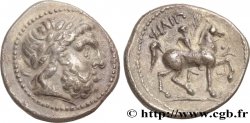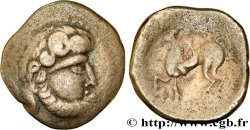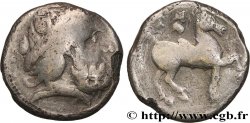bga_959319 - DANUBIAN CELTS - IMITATIONS OF THE TETRADRACHMS OF PHILIP II AND HIS SUCCESSORS Tétradrachme
250.00 €(Approx. 270.00$ | 207.50£)
Quantity
Add to your cart

Type : Tétradrachme
Date: (IIe-Ier siècles avant J.-C.)
Metal : silver
Diameter : 24 mm
Orientation dies : 2 h.
Weight : 12,58 g.
Rarity : R2
Coments on the condition:
Monnaie idéalement centrée. Joli portrait de Zeus, bien venu à la frappe. Revers agréable. Patine grise
Catalogue references :
Obverse
Obverse legend : ANÉPIGRAPHE.
Obverse description : Tête laurée de Zeus à droite ; grènetis.
Reverse
Reverse description : Cavalier au pas à droite, tenant une palme de la main droite ; le cheval lève l'antérieur à droite ; entre les jambes du cheval, une torche.
Reverse legend : FILIP - POU
Commentary
Si le statère d’or de Philippe II de Macédoine a servi de prototype à de nombreuses imitations gauloises, le tétradrachme n’a pas été imité en Gaule, mais reste principal sujet d’inspiration des monnaies pour les Celtes du Danube (LT. 9697-9767, 9768-9832, 9618-9630, 9870-9886). Les premières imitations furent frappées dans le premier quart du IIIe siècle avant J.-C. La fabrication des copies serviles, puis des imitations, enfin des frappes celtiques continuèrent pendant plus de deux siècles.
Cet exemplaire est d’un très bon style, encore très proche du prototype.
Cet exemplaire est d’un très bon style, encore très proche du prototype.








 Report a mistake
Report a mistake Print the page
Print the page Share my selection
Share my selection Ask a question
Ask a question Consign / sell
Consign / sell
 Full data
Full data









